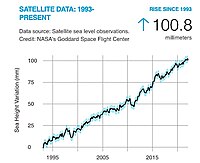
Photo from wikipedia
Wetlands are endangered ecosystems that provide vital habitats for flora and fauna worldwide. They serve as water and carbon storage units regulating the global climate and water cycle, and act… Click to show full abstract
Wetlands are endangered ecosystems that provide vital habitats for flora and fauna worldwide. They serve as water and carbon storage units regulating the global climate and water cycle, and act as natural barriers against storm-surge among other benefits. Long-term analyses are crucial to identify wetland cover change and support wetland protection/restoration programs. However, such analyses deal with insufficient validation data that limit land cover classification and pattern recognition tasks. Here, we analyze wetland dynamics associated with urbanization, sea level rise, and hurricane impacts in the Mobile Bay watershed, AL since 1984. For this, we develop a land cover classification model with convolutional neural networks (CNNs) and data fusion (DF) framework. The classification model achieves the highest overall accuracy (0.93), and f1-scores in woody (0.90) and emergent wetland class (0.99) when those datasets are fused in the framework. Long-term trends indicate that the wetland area is decreasing at a rate of –1106 m2/yr with sharp fluctuations exacerbated by hurricane impacts. We further discuss the effects of DF alternatives on classification accuracy, and show that the CNN & DF framework outperforms machine/deep learning models trained only with single input datasets.
Journal Title: IEEE Journal of Selected Topics in Applied Earth Observations and Remote Sensing
Year Published: 2021
Link to full text (if available)
Share on Social Media: Sign Up to like & get
recommendations!